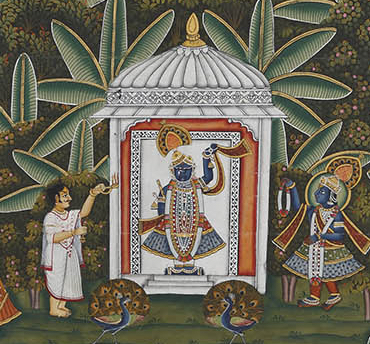All photographs © Sarmaya Arts Foundation
Once upon a time not too long ago, the Indian subcontinent was the toshakhana or treasure chest of the world. It represented a happy coming together of: mineral-rich lands yielding the finest Kashmiri sapphires, Burmese and Ceylonese rubies and Golconda diamonds; an enduring tradition of royal patronage; and flourishing karkhanas that attracted the most accomplished of designers and craftspeople. Jewellery has long been an integral part of India’s traditional and aesthetic identity, especially among the rulers of the land.
We have already explored how powerful men once signaled their supremacy with the use of jewels. Now let’s examine certain key pieces and gemstones favoured by the best-dressed royals. We start with the Nizams for obvious reasons. Rulers of the city of Hyderabad and the Deccan region, the Nizams were one of the wealthiest dynasties the Subcontinent had seen. According to this article in The Hindu, “The Nizam’s Dominion encompassed parts of Karnataka, Maharashtra and Andhra Pradesh besides the core area of present-day Telangana. Out of the whole area, nearly 10,000 square miles of land was classified as Sarf-e-Khas or crown lands. The revenue from these vast land-holdings was for the personal use of the Nizam. It was this source of revenue that led Time magazine to designate Mir Osman Ali Khan as the richest man in the world (for its 1937 cover), with a fortune estimated at nearly $2 billion.”
The Nizams possessed the most elaborate heirlooms that the Indian subcontinent ever housed, including gemstones, jewellery, art objects and paintings that dated back to the reign of Asaf Jah in the early 18th century. Besides being wealthy, the Nizams also initiated a hybridisation of crafts, borrowing and refining the artistic accomplishments previously made by the Mughals. Their obsession with magnificence was most apparent in their jewellery collections, especially in essentially Indian, even Hindu items such as turban ornaments (known variously as sarpatti, sarpech and kalgi) which were transformed to suit the more European tastes of the Nizams.
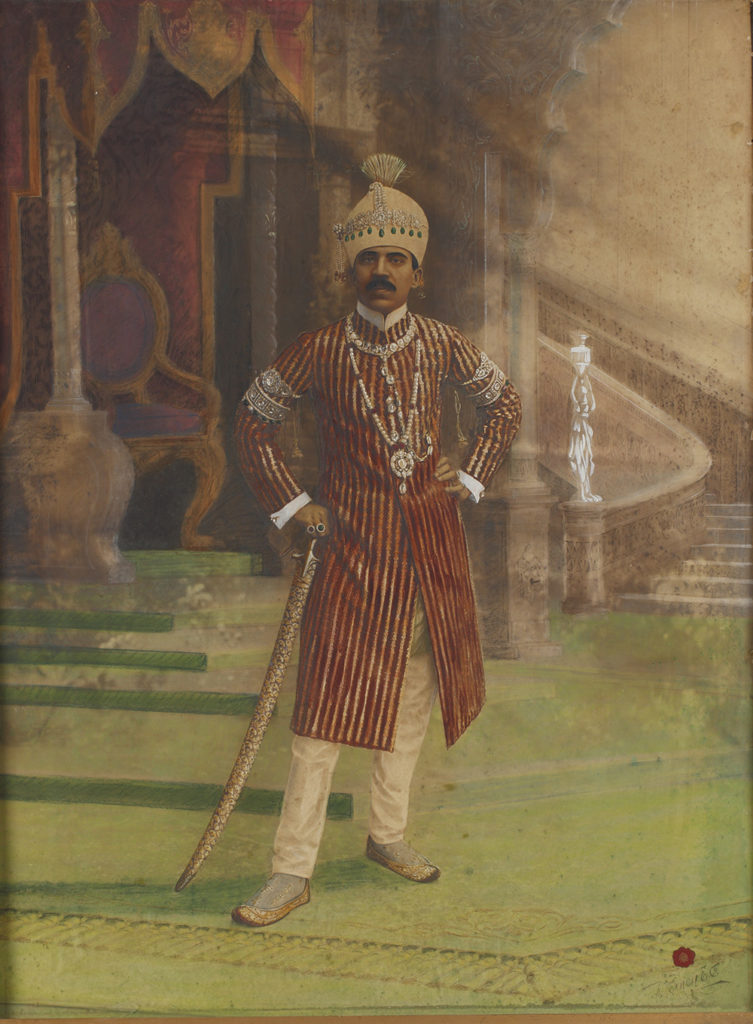
Painted Photograph of Asaf Jah VII Mir Osman Ali Khan Siddiqi, Nizam of Hyderabad, c.1911, by Vernon & Co
This image is of a painted photograph of Asaf Jah VII Mir Osman Ali Khan Siddiqi, Nizam of Hyderabad, c.1911, shot by Vernon & Co. On September 18th, 1911, Mir Osman Ali Khan became the seventh reigning Nizam of Hyderabad. At 35, he became the ruler and sole inheritor of the largest native princely state, a position he held until 1948 when Hyderabad was annexed to India. Vernon & Co. documented Osman Ali Khan’s coronation day with a series of portraits. Here, the Nizam is wearing his signature dastar or turban with a bejeweled elaborate sarpech or turban ornament. The front portion of this headpiece comprises of five openwork foliate cluster panels, set with table-cut diamonds that are then encased in gold. There are also nine emerald drops suspended along the edge of the sarpech piece. There is a lot of attention paid to accurately delineating and executing every detail in this piece of jewellery. Every flat diamond is encased in kundan (pure and malleable gold). The overall effect is perfectly symmetrical.
Large turban jewels such as this one were typically worn on exceptional occasions such as coronations, religious festivals and court ceremonies. Additionally, the Nizam also appears to be wearing several other articles of jewellery that include, a pearl and ruby haar (necklace) with a distinctive padak (pendant) set with rose-cut diamonds of different shapes embedded in gold, which hangs from a string of beautiful Basra pearls interspersed with rubies. He is also wearing a kanthi (necklace) that is encrusted with stunning oval-shaped diamonds. The Nizam is wearing the mandatory three sets of bazubands (armbands) on each arm, one in a floral diamond pattern, one with square-set diamonds and the other in an intricate setting of emeralds and diamonds. Lastly, he is wearing two angushtaris or challas (rings) on each of his hands, with central rubies and emeralds lined with small diamonds along the circumference. The shamsheer (sword) was a part of the Asaf Jah treasury inherited by later Nizams.
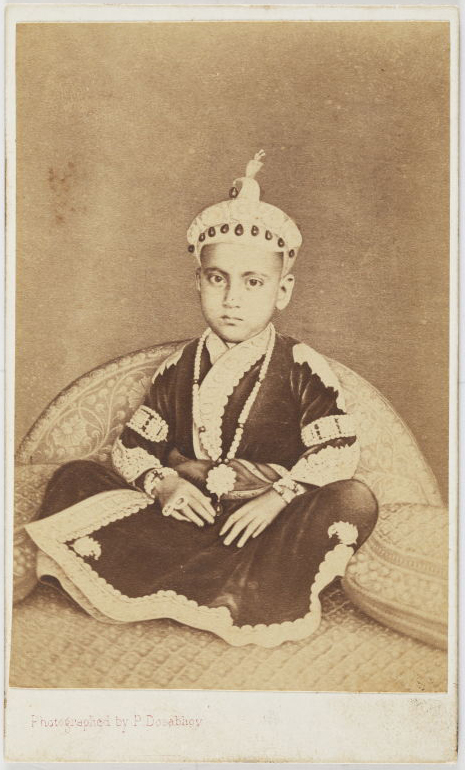
Portrait of Asaf Jah VI Mir Mahboob Ali Khan Siddiqi, Nizam of Hyderabad, c.1870s, by Pestunjee Dosabhoy
In this photograph of his father, Asaf Jah VI Mir Mahboob Ali Khan Siddiqi (reign: 1869 to 1911), we see the kid’s version of Mir Osman Ali’s Mughal majesty. Mahboob Ali Khan is assumed to be around six or seven years old in the photograph. He is dressed in traditional court costume, of a loose velvet robe with detailed goldthread embroidery. The young regent is adorned with lavish jewels, the most prominent of which is his diamond sarpech. It is set with flat diamonds in five foliate panels and has a curving plume like structure at the top. The delicately designed ornament has several spinels of pristine quality suspended along one edge. He is also wearing a pearl string haar with a prominent diamond rose-cut padak, the mandatory bazubands and challas.
Apart from the Nizams, other notable Indian royals with a treasure trove of precious jewels included the Gaekwad family of Baroda. Maharaja Sayajirao III, the twelfth ruler of Baroda ascended the gadi or throne in 1875 and ruled until 1939. In this photograph, we see the Maharaja wearing a magnificent seven-stranded pearl necklace. This was one of the most intricate and precious pieces of jewellery to be made at the time, and was also regarded as the most prized of the family’s heirlooms to be passed along through generations of Gaekwad rulers.
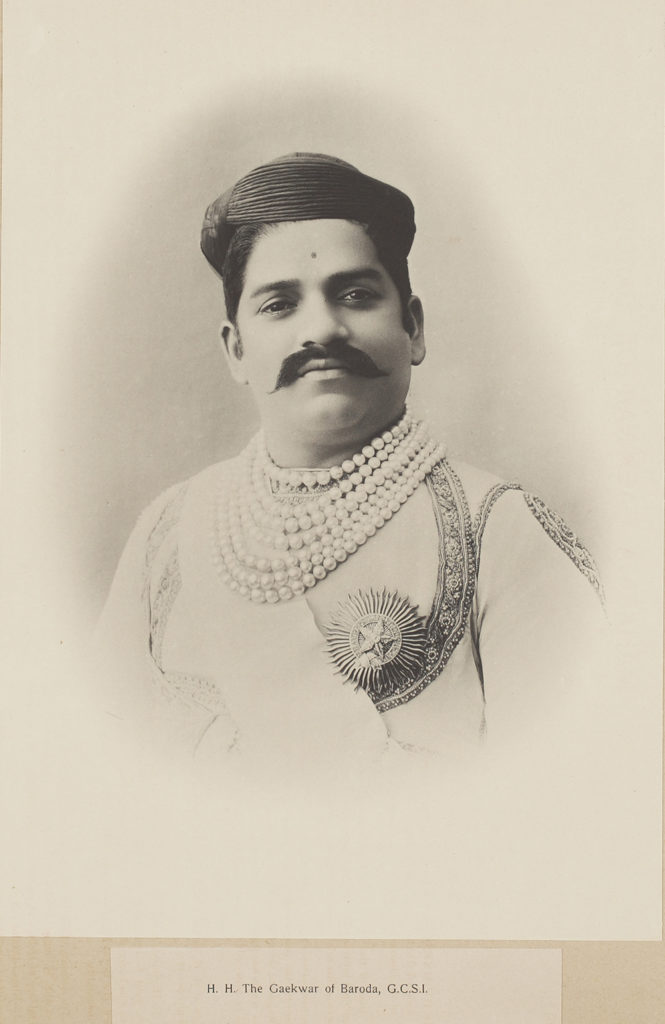
Portrait of Sayajirao Gaekwad III, Gaekwad of Baroda
As is evident in this photograph, the seven-stranded pearl necklace was a statement piece that required no additional accessorising. The beauty and symmetry of the nearly identical pearls that made up this piece marked it out for international acclaim. A photograph of Sayajirao III wearing the jewel was published in a 1908 book by the respected American gemologist and collector, George Frederick Kunz. The book—titled The book of the pearl; the history, art, science, and industry of the queen of gems—described this necklace as “seven rows of superb pearls whose value is estimated at half a million dollars”—that’s over 13 million dollars in today’s currency. The book speaks also of a shawl or carpet of pearls in the Baroda treasury that measured 10.5 feet in length and 6 feet in width. The family’s love for the ‘queen of gems’ is evident two generations later in this wedding portrait of the Sayajirao III’s grandson in 1929. The groom is wearing a three-string pearl necklace with a pearl pendant. His ceremonial headdress also comprises of a lavish cascade of smaller pearls.
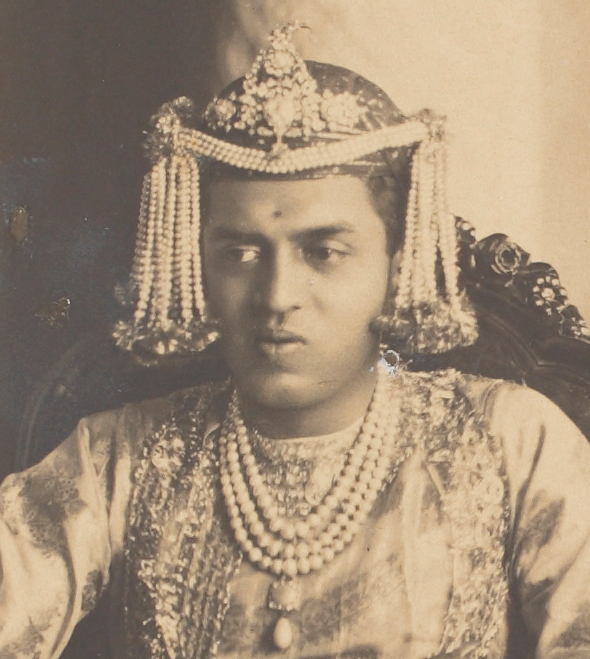
Wedding photograph of the grandson of Sayajirao III Gaekwad of Baroda, 1929
Apart from the Nizams and the Gaekwars, the rulers of princely states like Ratlam, Benares and Kapurthala too had a sweet spot for jewellery. In this portrait of Maharaja Shrimant Sir Ranjit Singhji Sahib Bahadur of Ratlam, he wears a dastar or turban covered in a mesh of intricate sarpattis made of diamonds, pearls and other precious gemstones. Additionally, he is also wearing a kundan haar made of diamonds, pearls and gemstones, and a pearl choker and earrings. Even the Maharaja’s angarkha is covered in a decorative pattern of sequins and gold thread.
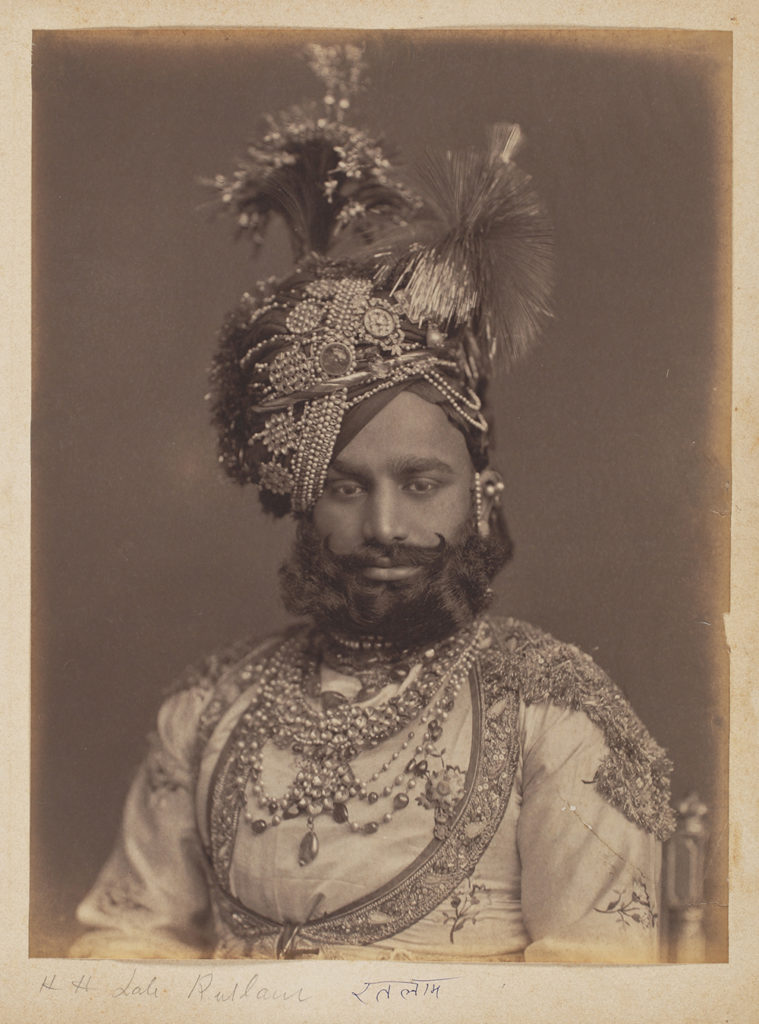
Similarly, Maharaja Prabhu Narayan Singh of Benares (reign: 1889 to 1931) too believed in taking the royal jewels out for the occasional airing. In this photograph, he is seen wearing a stunning haar made of kundan diamonds in a circular pattern, coupled with other precious gemstone spinels attached along the bottom and top edges of the haar. He wears the typical sarpech with the attached feather plume, as well as several other intricate articles of jewellery, include pearl and polki diamond shoulder pads, bazubands, a bejewelled belt and a bejewelled sword, bracelets and rings—all with his ceremonial court outfit and the Star of India brooch, an honour conferred to select Indian rulers by the British Crown.
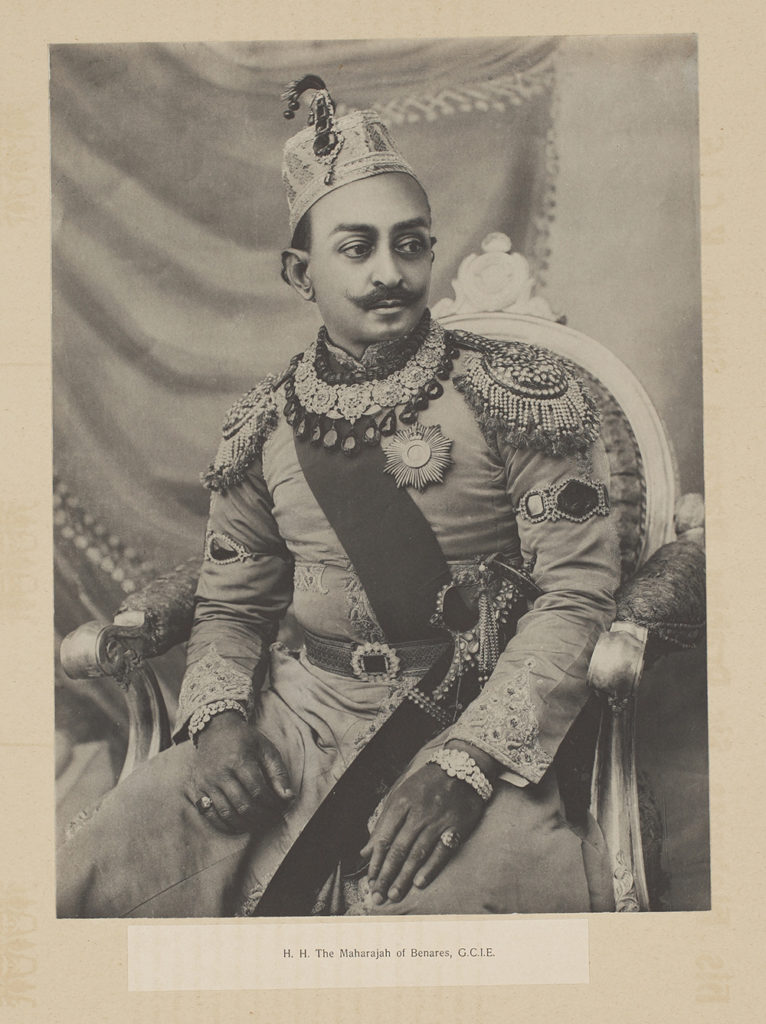
Portrait of Maharaja Prabhu Narayan Singh Bahadur of Benares
No list of bejewelled Indian royalty would be complete without mention of the Maharaja of Kapurthala, in present-day Punjab. Sir Jagatjit Singh Bahadur, who reigned from 1877 to 1947, was considered to be a style icon and possessed some of the most exquisite articles of jewellery that the Indian subcontinent had ever seen. In this photograph, the Maharaja is seen wearing the most recognisable object in his treasury: a Cartier emerald and diamond sarpech. This royal turban ornament was specially commissioned by the Maharaja to be designed by the renowned French jewellery house.
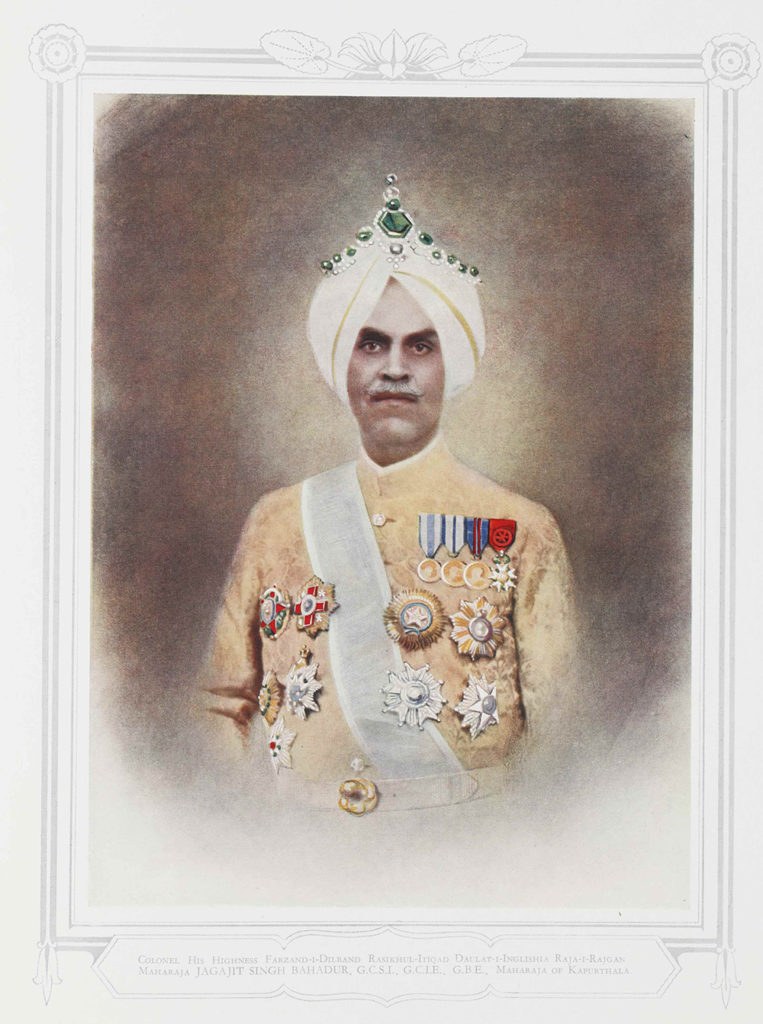
Maharaja of Kapurthala Sir Jagatjit Singh Bahadur
The Maharaja would go on to wear this ornamental headdress in several of his court portraits from 1926 onwards. The largest hexagonal emerald in this ornament is estimated to weigh around 117.40 carats. It was one of the earliest commissions Cartier received from Indian royalty and one of the most famous of its time. The ornament features 19 emeralds of varying size, scale and dimension, with pearls and white diamonds as additional accents. The emeralds belonged to the vast collection of heirlooms and inherited dynastic jewels that belonged to the Maharaja, who then had them re-set into this modern and more masculine jewel. There are two specific occasions where the Maharaja of Kapurthala has been documented wearing this royal emerald ornament, once at the Silver Jubilee of King George the V of England in 1935 and two years later at the coronation of King George the VI in 1937.
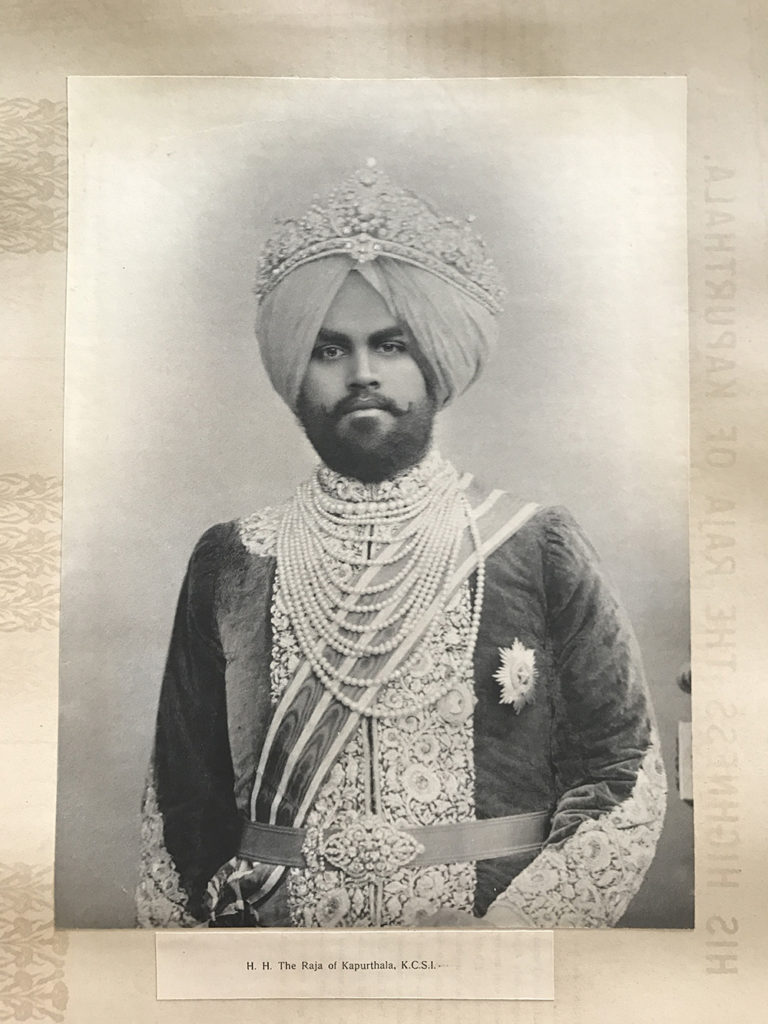
Maharaja of Kapurthala Sir Jagatjit Singh Bahadur
The Maharaja of Kapurthala’s appreciation of and affinity for grand jewels is apparent even in his younger court portraits like this one, where he wears a beautiful diamond crown and a 12-string Basra pearl necklace, along with a bejeweled diamond belt. He is seen wearing a traditional sherwani with gold brocade embroidery, along with his typical sash and the Star of India brooch. Even in this portrait it is clear that the Maharaja had a very keen eye for style, design and the presentation of his vast collection of precious jewels.
Abhiniti Ahuja is a Curatorial Assistant at Sarmaya
References:
- Treasures of the Deccan, Jewels of the Nizams by Dr Usha R Balakrishnan and Deepthi Sasidharan, 2018—part of the Sarmaya library
- Eragem-Cartier Turban Ornament for the Maharajah of Kapurthala
- Newsweek-There’s Nothing Else Like It In The World



